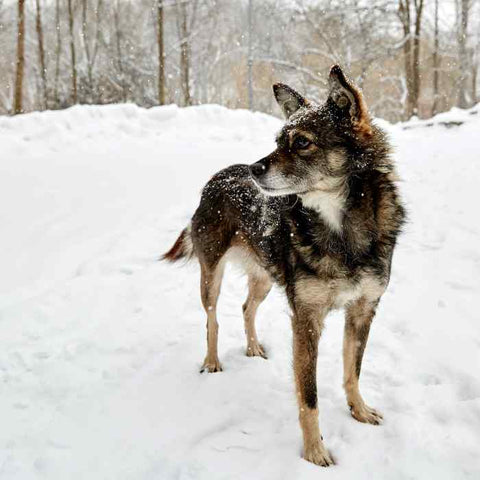When temperatures drop and the likelihood of snow and other wintry weather patterns increases, we (mostly) fur-free bipeds break out the winter jackets and snow boots.
Especially here in New York City. But are humans the only ones who need to rock special winter gear during the coldest months of the year, or do dogs need snow boots to protect themselves, too?
As with many things concerning pet care, the answer is not a clear-cut yes or no. Here’s what you need to know to decide if and when dog snow boots are right for your dog.

Does Your Dog Need to Wear Boots in the Cold Weather?
When it comes to asking whether or not your canine companion should wear boots during the winter and cold weather, it truly depends on your dog’s tolerance for cold, how cold it is outside, what’s happening under their paws, and several other important factors.
Short-haired dogs, small dogs, and breeds that are susceptible to the cold may need a dog jacket or sweater outdoors. And no matter how hardy your dog is, their paws should always be protected from snow, ice, salt, and ice melt chemicals. In a city setting, you can almost always expect salt on the sidewalks, and most road salts and deicers are completely toxic to dogs. Consider keeping their feet warm and safe with the proper gear and dog boots for winter.
Dogs Are Built for the Cold (for the Most Part)

While humans aren’t able to stand barefoot in the cold without risking discomfort and even frostbite, dogs can and will walk around in the cold and snow as if it’s no big deal, thanks to the amazing way their paws work. So when it comes to booting up strictly to combat the cold, mostdogs don’t need the extra protection for average cold-weather conditions. Dog winter boots are not always necessary.
Some breeds, such as Golden Retrievers and German Shepherds, enjoy chillier temperatures when they can run around without feeling overheated in their thick coats. Others, like Dachshunds and Beagles, tend to shy away from the cold, but can still be persuaded to get in a quick romp outside, especially with the right protection.
Your furry friend has paw pads are made up of adipose tissue and elastic fibers, which are in turn covered by heavily pigmented, thick skin. All of these elements inhibit freezing, of course, but that’s not the only thing that allows them to frolic in the snow or go on winter walks without a dog boot.
Recent research has shown that it’s not just the combination of fat, fiber, and thick skin that keeps dog feet warm; canines also have a special circulatory system within their paws that places arteries and veins in close proximity and allows warm blood to be circulated more quickly.
Also found in penguins and dolphins, it’s essentially a heat exchange system that brings warm blood from the body down into the paws, heating the blood that has been close to cold surfaces before it circulates throughout the rest of the dog’s body. This keeps their entire body temperature stable and allows them to comfortably amble around sans extra protection.
That said, not all dogs are equipped to keep themselves warm enough to withstand winter temperatures and conditions like snow and ice.





